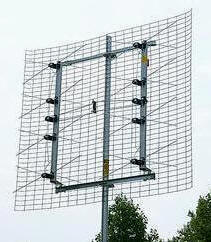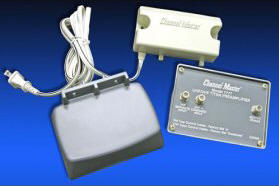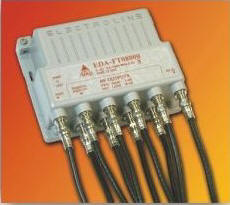
 The subject of digital TV antennas and DTV reception is complex and would necessitate a whole discussion on its own. As such, in this short guide to DTV reception, we would limit ourselves to a few TV reception basics but that can still make a whole difference when it comes to receiving weak DTV signals.
The subject of digital TV antennas and DTV reception is complex and would necessitate a whole discussion on its own. As such, in this short guide to DTV reception, we would limit ourselves to a few TV reception basics but that can still make a whole difference when it comes to receiving weak DTV signals.
Digital terrestrial television operates within the same VHF/UHF bands assigned to analog TV. This means that the same television antennas apply. Yet in view of the broadcast channel re-allocations we referred to in our on digital television, you may need to use a different antenna for the reception of DTV.
Digital TV antennas may be divided into outdoor and indoor. Furthermore, outdoor TV antennas may be further sub-divided into grouped antennas and wideband.
Grouped antennas—like Yagi antennas (consisting of a main boom with a number of arms running perpendicular to it)—are tuned to cover only a portion of the respective VHF or UHF band. This means that when it comes to grouped antennas, you may need more than one antenna to cover the full range of TV broadcast channels covering your area. On the other hand, grouped antennas provide a far greater forward gain than wideband multi-directional antennas such as bowtie type antennas, and therefore are more suitable for long-range reception.
 Outdoor and Indoor Antennas
Outdoor and Indoor Antennas
As long as you live in a primary DTV reception area, a good inexpensive indoor digital TV antenna such as the featured at top of this page, should help you receive most of the available DTV channels in your area.
TV antennas such as the Terk are 'directional' type. This means that for best DTV reception, you will have to direct your indoor DTV antenna with its long boom pointing in the same direction as the transmitting TV station.
Directional type antennas provide a much higher gain in the forward direction; the Terk provides a 12dB gain thanks to its built-in antenna amplifier. A directional antenna helps minimize DTV interference from other broadcast stations (as long as these do not fall within the same line-of-sight) due to its narrow acceptance angle. This higher gain along the forward path also helps make up for the significantly higher signal loss associated with the indoor reception of digital TV RF signals.
However...
|
To make the most out of your digital TV reception, you have to go outside! VHF and UHF signals travel in straight lines and therefore can be obstructed by hills and tall buildings. Ideally, you should place your antenna outside, positioned as high as possible and pointing towards the transmitting station covering your area. However, keep in mind that outdoor antennas do suffer from deterioration due to their exposure to the elements; they should therefore be checked periodically.
In general, depending on building construction, you can expect to lose anything from 30% to 70% of the signal when mounting your digital TV antenna inside. The signal loss can even reach 100% in houses with metal (aluminum) siding. |
The is a wide-band (Channels 14-69), long-range 8-way bowtie dipole design directional antenna with a maximum gain of 15.8dB and a beam width of 15 degrees. Designed for use outdoors, though it can also be used indoors (e.g. in the attic), it provides exceptional performance especially in fringe DTV reception areas up to 60 miles away from TV transmitters. Antenna size: 39.5"W x 5.3"D x 36.4"H |
This means that the use of indoor digital TV antennas—whether in the form of a full size antenna mounted in the attic, or a specifically designed indoor DTV antenna—is recommended only in good reception areas. An outdoor installation would always yield better reception results.
Masthead Amplification and Distribution Amplifiers
If you live in an area where the signals are weak, or need a very long downlead to feed your TV, you may require amplification either through the addition of a separate masthead amplifier such as the featured here, or through the use of an active digital TV antenna. The latter is a TV antenna with a built-in amplifier situated within the antenna junction box itself.
Masthead amplifiers should be mounted close to the antenna to avoid amplification of noise and other interference picked up via the downlead. Furthermore, both masthead amplifiers and active DTV antennas require a power feed that is provided via the antenna downlead itself.
While in general, it is best to avoid masthead amplifiers and amplified TV antennas when it comes to digital TV reception, if used properly masthead amplification can be beneficial. Their use is mainly recommended only if the signal level received when using a passive digital TV antenna is too low to achieve the necessary decoding margin for your DTV converter box or digital TV tuner to constitute the image.
If you are already experiencing interference, or ghosting (multiple images of the same picture superimposed on each other as a result of signal reflections from tall structures, trees, etc.), the use of amplification will further aggravate these problems since interference signals will be amplified as well.
 Mounting your digital TV antenna inside the attic, while providing total protection from the elements, can lead to weak reception as roof tiles, insulation, water tanks, etc., can screen the antenna from the incoming signal.
Mounting your digital TV antenna inside the attic, while providing total protection from the elements, can lead to weak reception as roof tiles, insulation, water tanks, etc., can screen the antenna from the incoming signal.







